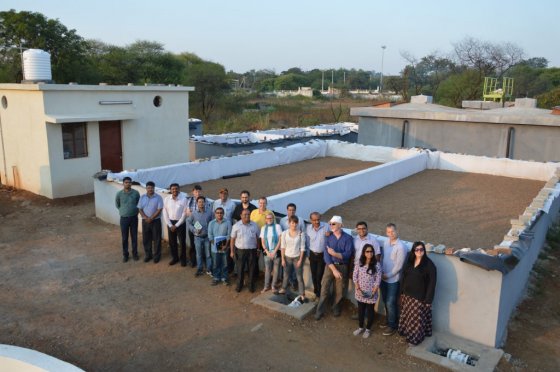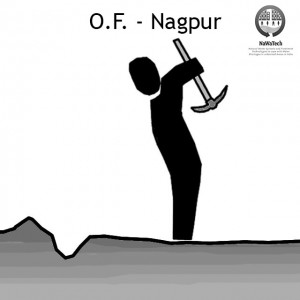Executive Summary
The system considered in this NaWaTech case study is located at the Ordnance Factory Ambajhari (OFAJ), Govt. of India, Nagpur, Maharashtra, India. It provides sewage management for at least 1000 population equivalent and consists of a main treatment line featuring anaerobic pre-treatment, horizontal flow constructed wetlands, and sludge drying reed bed as well as a pilot line with a French type constructed wetland system and a short rotation plantation. It provides recycled water for a multipurpose lawn to prevent the use of fresh water in gardening.
| The contents of this factsheet are results of the Indo-European Project NaWaTech- “Natural Water Systems and Treatment Technologies to cope with Water Shortages in Urbanised Areas in India”, co-financed by the EC and the DST – India. |
The Ordinance Factory Ambajhari estate holds residential quarters for the employees of the factory. Currently, the untreated sewage is directed towards the wastewater treatment plant and the treated water is discharged into the nearby stream. However, in order to reduce the fresh water consumption on site (e.g. for irrigation purposes, current average water requirement for this is approx. 100 m3/d) wastewater can also be treated to facilitate reuse.
The solution proposed in this case study to achieve this is a system composed by modular units of different engineered natural treatment systems in combination. The entire system can serve 250 households (1000 p.e.), with the main users being people living in the residential colony of the factory, as well as users of the sports complexes.
The main treatment system consists of a bar screen chamber, oil and grease trap, inlet sump, primary clarifier, improved up-flow anaerobic filter followed by subsurface horizontal flow constructed wetland (HF-CW), cascade aerator, dual media and activated carbon columns and finally UV disinfection. The improved anaerobic filter ensures substantial removal of organic matter, wherein a specially designed filter media is used for microbial growth. Treated effluents from the anaerobic filter are fed by gravity into two parallel HF-CWs, which ensure the removal of remaining organics and nutrient reduction. Thereafter, treated wastewater is pumped to the cascade aerator to infuse dissolved oxygen and enhance the quality of effluent. The aerated wastewater is subsequently conveyed for tertiary treatment comprised of a dual media filter followed by granular activated carbon column. Disinfection through UV is provided to the final treated effluent, which is then ready to be recycled and reused for various non-potable uses of the community. The expected performance of the improved treatment system indicates that treated effluent with less than 5 mg/L BOD and TSS as well as < 10 mg/L COD will be obtained. The settled sludge from the primary clarifier will be treated in sludge drying reed beds, permitting the final reuse of the sludge as soil conditioner and avoiding any external disposal.

NaWaTech Consortium at the Ordnance Factory site. Source: NAWATECH (2015)
Furthermore, a pilot line for the treatment of 3 – 8 m3 wastewater with a two-stage constructed wetland constituted by French reed bed (FRB) and subsurface vertical flow constructed wetland (VF-CW) in combination with a invalid link is implemented. This pilot aims to demonstrate the applicability of the so-called “French Scheme” in the Indian context. This treatment scheme can offer several advantages such as the minimum possible footprint for passive natural treatments or the absence of primary sedimentation, i.e. no production of primary sludge by septic tanks or similar tools - the raw wastewater upstream the primary clarifier is fed directly into the 1st stage bed, only following a screen chamber and an oil and grease trap. Solids and the surplus of biomass remain on the top of the gravel surface, forming an active layer that enhances performance and permits sludge dehydration and stabilization. This active layer can grow 1-2 cm each year, until the hydraulic conductivity is too reduced and the sludge layer has to be removed (after approx. 10 years). The quality of the treated water, by the fact that the process is based on filtration, is remarkably constant and will be used to feed a short rotation plantation (SRP) via drip irrigation. SRPs are plantations of fast-growing trees regularly harvested in short intervals for the production of mainly fuel- and pulpwood. For the SRP system in Nagpur local species suitable for wastewater treatment were selected: Melia Dubia and Bambusa Bambos.
Among the major advantages of the treatment systems are the requirement of low operation and maintenance costs, low energy needs, possible management with unskilled manpower and the high efficiency in removing primary, secondary and tertiary pollutants. Thanks to the system implementation, multipurpose lawn, orchards and gardens will be irrigated daily with approx. 100 m3/d of treated and safe water. Lessons learnt from this case study stress the importance of preparatory work (such as feasibility study, information about geological, wastewater characteristics, etc.), stakeholder involvement, or capacity-building activities of selected contractors (for more information visit planning and process tools introduction). The successful implementation at OFAJ may result in further replication of such systems at other Ordnance Factories across the country.
Wastewater Treatment and Reuse at the Ordnance Factory Ambajhari, Nagpur, Maharashtra, India
This document present a detailed description of the case study implemented at the Ordnance Factory Ambajhari, Nagpur, including history of the project, design information, materials and project components, costs and economics, and details about operation and maintenance, practical information and lessons learnt.
LABHASETWAR, P. ; POPHALI, G. (2015): Wastewater Treatment and Reuse at the Ordnance Factory Ambajhari, Nagpur, Maharashtra, India. Case Study. In: NaWaTech project:Compendium of Natural Water Systems and Treatment Technologies to cope with Water Shortages in Urbanised Areas in India
The Compendium of NaWaTech Technologies presents appropriate water and wastewater technologies that could enable the sustainable water management in Indian cities. It is intended as a reference for water professionals in charge of planning, designing and implementing sustainable water systems in the Indian urban scenario, based on a decentralised approach.
BARRETO DILLON, L. ; DOYLE, L. ; LANGERGRABER, G. ; SATISH, S. ; POPHALI, G. (2013): Compendium of Natural Water Systems and Treatment Technologies to cope with Water Shortages in Urbanised Areas in India. Berlin: EPUBLI GMBH URL [Accessed: 11.12.2015]Manual on Sewerage and Sewage Treatment. Part A: Engineering
This manual is part A of the updated manuals on sewerage and sewage treatment, prepared by the Central Public Health and Environmental Engineering Organisation (CPHEEO), a department under the Ministry of Urban Development, India. These manuals aim at meeting the professional needs of practising engineers dealing with the sanitation sector in the country that focuses on achieving the goal of 'sanitation for all' within a reasonable timeframe. Part A of the manual is on Engineering aspects related to sewerage system.
CPHEEO (2012): Manual on Sewerage and Sewage Treatment. Part A: Engineering. New Delhi: The Central Public Health and Environmental Engineering Organisation (CPHEEO), Ministry of Urban Development, Government of India URL [Accessed: 04.02.2013]Wastewater Treatment and Reuse at the Ordnance Factory Ambajhari, Nagpur, Maharashtra, India
This document present a detailed description of the case study implemented at the Ordnance Factory Ambajhari, Nagpur, including history of the project, design information, materials and project components, costs and economics, and details about operation and maintenance, practical information and lessons learnt.
LABHASETWAR, P. ; POPHALI, G. (2015): Wastewater Treatment and Reuse at the Ordnance Factory Ambajhari, Nagpur, Maharashtra, India. Case Study. In: NaWaTech project:http://www.nawatech.net/
This is the official webpage of the NaWaTech Collaborative Project, containing all key information related to the different case studies, activities and results of the project.



